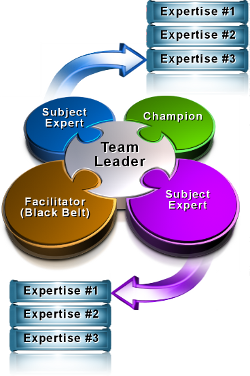When embarking upon a Lean Six Sigma continual improvement program, there are a number of deployment steps, which will help enhance the success of the program.
Step #1: Executive Training
A Lean Six Sigma continual improvement program requires understanding and commitment from everyone in the organization. This understanding and commitment must start at the top. The leadership group plays an important role in creating the urgency and demonstrating its commitment to the program and communicating their support throughout the organization. In this step, the leadership group is made aware of their role and responsibilities so they can decide if they are ready to make the commitment necessary to make the program successful.
Step #2: Establish a Steering Committee
Once the leadership group has agreed to their support of the program, a steering committee is established to oversee and manage the program. The steering committee is made up of individuals, from the leadership group, who have the power to allocate resources. Another key function of this group is to select projects, which will have a strategic impact on the organization. Each potential project is evaluated on its relative contribution to the achievement of the strategic objectives. This creates a prioritized list of projects to choose from.
This group is also responsible for selecting which projects to engage, assigning teams to those projects and tracking the status. When a project team encounters roadblocks, this group must remove them. The steering committee generally meets once a month to review potential projects and to get team updates on the status or completion of a project.
Step #3: Establishment of a Project Hopper
Potential projects can be identified from a multitude of sources, including; the strategic plan, customers, employees, value stream maps, departments and others. Each of these potential projects is evaluated as to strategic impact by the steering committee and placed in the project hopper. The project hopper is just a prioritized list of ongoing and potential projects maintained in a spreadsheet. The project hopper is reviewed at every steering committee meeting.
Step #4: Employee Awareness Training
In order for any Lean Six Sigma continual improvement program to be successful, everyone in the organization has to understand why it is important and how they can contribute to its success on a daily basis. For this reason, all employees must be made aware that the program is going to be launched and provided with knowledge on the concepts, terminology, importance and their role. The employees are the ones who will have to practice the new process after implementation and will be key to sustaining the gains without backsliding.
Step #5: Employee Skills Training
As project teams are assembled, employees will be asked to participate in some of the following roles:

- Champion: The person who is usually a member of the steering committee that has a big title and the ability to write checks and remove roadblocks.
- Team Leader: The person with the most to gain with the successful completion of the project.
- Facilitator: The one who understands all of the Lean Six Sigma tools that may need to be used in order to complete the project.
- Recorder: The one who records all of the notes, assignments and completed tasks for the project. This individual can change from meeting to meeting.
- Subject Matter Expert: The individuals who have the most knowledge about the process being addressed by the project. They also serve as a liaison to their work area, harvesting ideas from people not on the team.
In order to help employees be better team members, this training helps develop various skills including Team Oriented Problem Solving (TOPS).
Step #6: Select Projects and Assign Teams
After the steering committee selects which projects to undertake and assigns people to the team, the Champion and Team Leader draft and sign a Project Charter, which defines the objectives, problem or opportunity, team members, and resources needed to successfully complete the project. The team will generally meet once a week, (more if necessary), to discuss the project, assign tasks, review status and accomplishments, identify roadblocks and anything else pertinent to the project.
